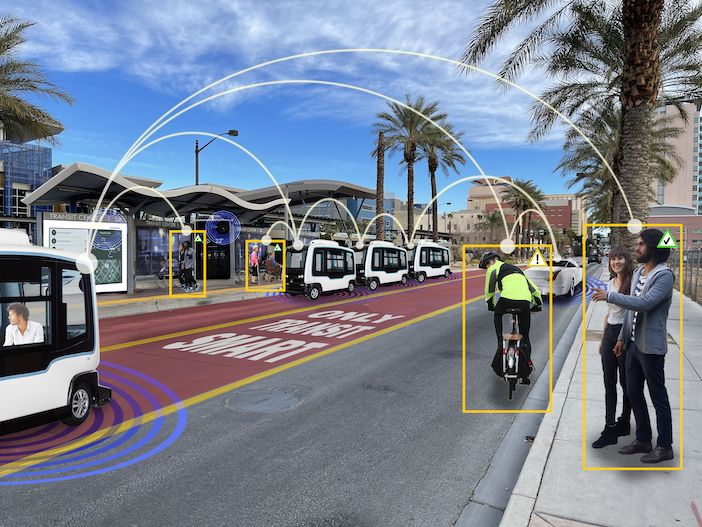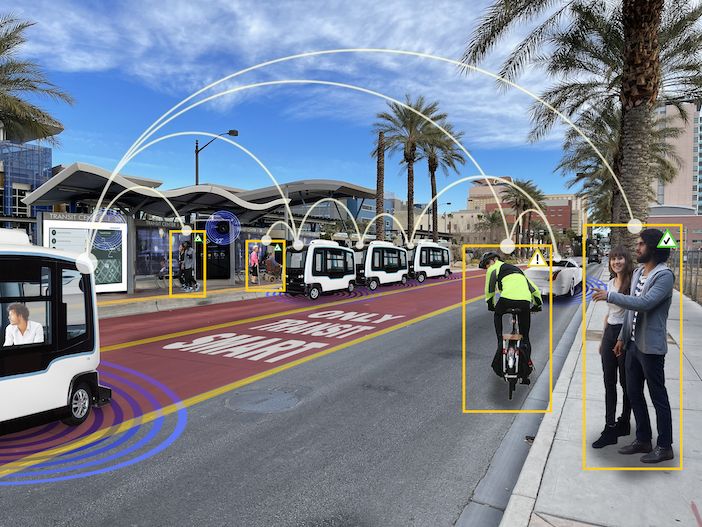The Regional Transportation Commission (RTC) of Southern Nevada has selected global design firm Stantec to lead the implementation of the GoMed Program – its vision for safer and more efficient travel to, from, and within the Las Vegas Medical District (LVMD).
The advanced mobility program will include planning and implementation for the seamless integration of autonomous vehicles (AVs), connected technologies, traffic and data management, and user software interface. The GoMed Program will be one of the first long-term deployments of AV shuttles in the world.
“We are delighted to be a partner in this cutting-edge project. Las Vegas is leading the way in deploying autonomous vehicles to solve real-world problems, building a more sustainable transportation system for the future,” says Kate Jack, smart mobility lead at Stantec. “By deploying these shuttles from downtown to the medical district, we are providing a stress-free and accessible mobility solution for patients and staff.”
GoMed – also known as the Automated Circulator and Connected Pedestrian Safety Program – is largely funded through a United States Department of Transportation (USDOT) BUILD program award and will be jointly delivered by the RTC and the City of Las Vegas. The program demonstrates the ability to apply connected and automated technology in a complex urban setting, and will integrate connected technologies like automated pedestrian detection to enhance safety. Las Vegas has been on the forefront of new mobility, including the Fremont Street pilot, the first driverless shuttle pilot in the United States, where Stantec staff provided program management, vehicle testing plans, and AV strategies.

Prioritizing safety, accessibility, equity, and a friendly user experience will be central to the GoMed strategy. The on-demand service offered by connected and autonomous technology will deliver patients and staff to LVMD locations and nearby transit facilities efficiently and comfortably, inclusive of those with disabilities. The solutions applied to the 674-acre cluster of hospitals, clinics, and the University of Nevada, Las Vegas School of Medicine will be scalable and replicable city-wide, providing potential long-term mobility solutions for the Las Vegas Valley.
“We have a longstanding relationship with both the RTC and the City of Las Vegas, and we are thrilled to be part of this revolutionary project,” said Brian Norris, project manager and Stantec’s Transportation Business Leader. “We see our role in this project as more than just a consultant – we’ll be a mobility partner to RTC and the City every step of the way from planning and implementation to ribbon cutting.”
The planning and engineering of vehicle to infrastructure (V2I) technology will be a critical component in the integration of connected technologies, from the user experience to traffic management, and all the sensors in between. AV vehicle planning, vendor selection, and operational rollout will be guided by Stantec’s GenerationAV Deployment Playbook.
Stantec’s Smart Mobility practice has been engaged in numerous notable projects, including the launch of ACTIVE-AURORA, Canada’s first Connected Vehicle Testbed; Tennessee’s statewide traffic management center upgrade; Tulsa, OK’s Mobility Innovation Strategy; and the engineering behind the Intelligent Transport Systems that enabled autonomous shuttles in Montreal, the first self-driving vehicles on urban public roads in Québec. In Dubai, Stantec worked with the Roads and Transport Authority to frame the city’s Self-Driving Code of Practice.
Find out more about Smart Mobility at Stantec.





